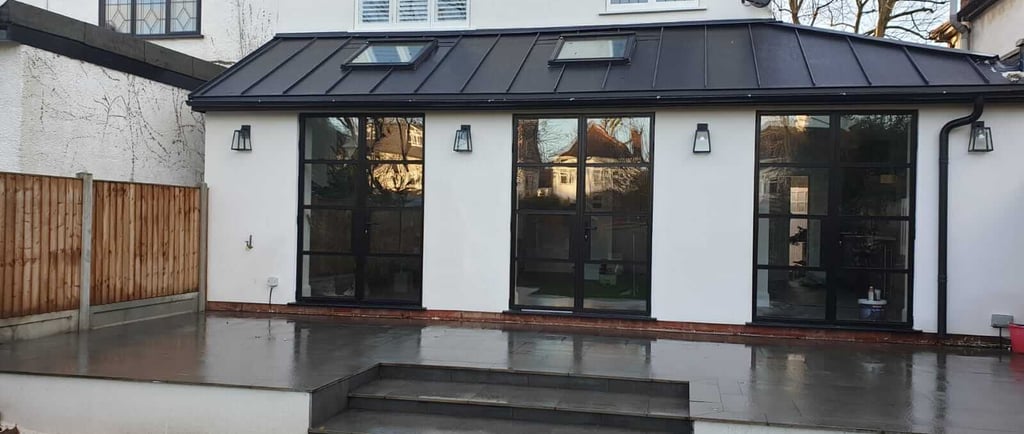Home Extensions UK 2025 | Costs, Ideas & Planning Permission Guide
5/10/20253 min read


Home Extensions in the UK: The Complete Guide for 2025
Are you dreaming of more space in your home but not quite ready to move? A home extension could be the ideal solution. Whether you're thinking about a spacious kitchen-diner, a home office, or even a new bedroom, extending your home adds not only space but also value.
In this blog post, we’ll walk you through everything you need to know about home extensions in the UK for 2025, including costs, planning permission, design ideas, building regulations, and trends.
Why Consider a Home Extension in 2025?
With property prices remaining high and the cost of moving continuing to rise, many UK homeowners are choosing to improve rather than move. A home extension allows you to tailor your space to your lifestyle—while potentially increasing your property’s value by up to 20–25%.
Key Benefits of a Home Extension:
🛋️ Extra living space for growing families
🏡 Tailored layouts that suit your lifestyle
💷 Adds significant resale value
🧾 Avoids the stress and expense of moving
🌱 Modern extensions are energy-efficient and sustainable
Types of Home Extensions in the UK
Choosing the right type of extension depends on your budget, needs, and the layout of your property.
1. Rear Extensions
Perfect for opening up kitchens or adding open-plan living spaces. Ideal for terraced or semi-detached homes.
2. Side Return Extensions
A popular option for Victorian or Edwardian terraced homes that transforms the narrow alleyway into functional interior space.
3. Wraparound Extensions
Combines rear and side extensions, creating a large L-shaped area. Great for maximizing footprint on corner plots.
4. Double-Storey Extensions
Adds space across both floors—ideal for an extra bedroom, en suite, or expanded living area.
5. Orangeries and Conservatories
Light-filled spaces that serve as dining rooms, lounges, or playrooms. Usually quicker and cheaper to build.
Home Extension Costs in the UK (2025 Estimates)
Extension Cost per m²
Single-Storey Extension in London £2,200–£3,500
Single-Storey Extension (Outside London) £1,800–£2,800
Double-Storey Extension in London £2,800–£4,000
Double Storey Extension outside London £2,200–£3,000
Side Return Extension in London £2,200–£3,200
Side Return Extension outside London £1,800–£2,500
Conservatory/Orangery in London £1,000–£2,500
Conservatory/Orangery outside London £800–£2,000
🧮 Don't forget to budget for architect fees (5–15%), structural engineering, planning applications, and VAT.
Do You Need Planning Permission for a Home Extension?
Under Permitted Development (PD) rights, many extensions do not require planning permission, especially single-storey rear extensions within set limits.
When Planning Permission Is Not Needed (England):
Rear extension is up to 6m (or 8m for detached homes)
Materials are in keeping with the existing house
Height is below 4m (single-storey)
No raised platforms or balconies
Always check with your local authority and get a Lawful Development Certificate.
You Will Need Permission If:
Your property is listed or in a conservation area
You're building a double-storey or wraparound extension
You’re near boundaries or exceeding PD limits
Building Regulations for Home Extensions
All home extensions in the UK must comply with building regulations. These include standards for:
Structural safety (Part A)
Fire safety (Part B)
Sound insulation (Part E)
Energy efficiency (Part L)
Ventilation (Part F)
Drainage (Part H)
A building control inspector will visit your site at various stages to inspect work and issue a completion certificate at the end.
Creative Ideas for Your 2025 Home Extension
In 2025, homeowners are focusing on flexibility, energy efficiency, and biophilic design (bringing nature indoors).
Trending Ideas:
Kitchen-Diner Extensions with skylights and bifold doors
Garden Offices with green roofs or modular pods
Glazed Corners for panoramic views and natural light
Sunken Living Rooms for split-level interest
Energy-Efficient Walls & Roofs using SIPs or eco-insulation
Crittall-Style Windows for a timeless industrial look
Tips for a Successful Home Extension
✅ Get multiple quotes from reputable builders
✅ Use a contract like JCT for peace of mind
✅ Plan for delays—especially in winter months
✅ Notify your insurer and mortgage provider
FAQs About Home Extensions
Q: How long does a home extension take to build?
A: 10–16 weeks for single-storey; longer for double-storey or complex builds.
Q: Do I need a Party Wall Agreement?
A: If your extension affects a shared wall with a neighbor—yes.
Q: Can I live in the house during the build?
A: Often yes, but expect disruption, dust, and noise.
Final Thoughts
A home extension is a fantastic way to adapt your home for modern living without the hassle of moving. With careful planning, trusted professionals, and a clear vision, your extension project can transform your daily life—and boost the value of your home in the process.
In 2025, smart, light-filled, and energy-efficient extensions are not just on trend—they’re future-proof.